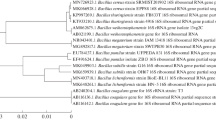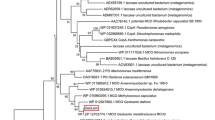Abstract
Bacterial laccases have received considerable attention because of several advantages associated with the higher environmental stability of these enzymes compared with fungal laccases. In this study, a laccase-like gene from Burkholderia cepacia BNS was successfully cloned. This gene was found to encode a mature protein of 279 amino acids that exhibited laccase activity in dimer form. The mature protein was found to contain approximately 4 mol of copper per monomer, and the metal ion-binding sites were predicted. BC_lacL gene transcription levels were analyzed by qRT-PCR to study expression patterns in the presence of different putative inducers (copper ions, guaiacol, veratryl alcohol, vanillin, coniferaldehyde, p-coumaric acid, sinapic acid, and ferulic acid). Copper ions had a positive effect on both transcription levels and intracellular laccase activity. Interestingly, upon induction with sinapic acid, BC_lacL gene transcription was lower than in the presence of copper ions, but laccase activity was highest under these conditions. The BC_lacL protein expressed in Escherichia coli exhibited a specific activity of 7.81 U/mg with 2,2′-azino-bis (3-ethylbenzothiazoline-6-sulfonic acid) (ABTS) as the substrate and 12.3 U/mg with 2,6-dimethoxyphenol (2,6-DMP) as the substrate after purification through Ni-affinity chromatography. The optimal activity and kinetic parameters of the recombinant BC_lacL protein were observed (kcat/Km = 3.96 s−1 μM−1) at a pH of 4.0 at 55 °C for ABTS oxidization and (kcat/Km = 11.6 s−1 μM−1) at a pH of 10.0 at 75 °C for 2,6-DMP oxidization. The protein exhibited high stability in an alkaline environment, with a half-life of more than 12 h. The same results were obtained via decolorization of eight dyes. Hence, this laccase-like enzyme may have potential industrial applications.





Similar content being viewed by others
References
Akyilmaz E, Yorganci E, Asav E (2010) Do copper ions activate tyrosinase enzyme? A biosensor model for the solution. Bioelectrochemistry 78:155–160. https://doi.org/10.1016/j.bioelechem.2009.09.007
Asgher M, Wahab A, Bilal M, Nasir Iqbal HM (2016) Lignocellulose degradation and production of lignin modifying enzymes by Schizophyllum commune IBL-06 in solid-state fermentation. Biocatal Agric Biotechnol 6:195–201. https://doi.org/10.1016/j.bcab.2016.04.003
Asina F, Brzonova I, Voeller K, Kozliak E, Kubátová A, Yao B, Ji Y (2016) Biodegradation of lignin by fungi, bacteria and laccases. Bioresour Technol 220:414–424. https://doi.org/10.1016/j.biortech.2016.08.016
Ausec L, Zakrzewski M, Goesmann A, Schlüter A, Mandic-Mulec I (2011) Bioinformatic analysis reveals high diversity of bacterial genes for laccase-like enzymes. PLoS One 6:e25724. https://doi.org/10.1371/journal.pone.0025724
Ausec L, Črnigoj M, Šnajder M, Ulrih N, Mandic-Mulec I (2015) Characterization of a novel high-pH-tolerant laccase-like multicopper oxidase and its sequence diversity in Thioalkalivibrio sp. Appl Microbiol Biotechnol 99:9987–9999. https://doi.org/10.1007/s00253-015-6843-3
Ausec L, Berini F, Casciello C, Cretoiu MS, van Elsas JD, Marinelli F, Mandic-Mulec I (2017) The first acidobacterial laccase-like multicopper oxidase revealed by metagenomics shows high salt and thermo-tolerance. Appl Microbiol Biotechnol 101:6261–6276. https://doi.org/10.1007/s00253-017-8345-y
Beck S, Berry E, Duke S, Milliken A, Patterson H, Prewett DL, Rae TC, Sridhar V, Wendland N, Gregory BW, Johnson CM (2018) Characterization of Trametes versicolor laccase-catalyzed degradation of estrogenic pollutants: substrate limitation and product identification. Int Biodeterior Biodegrad 127:146–159. https://doi.org/10.1016/j.ibiod.2017.11.020
Beloqui A, Pita M, Polaina J, Martínez-Arias A, Golyshina OV, Zumárraga M, Yakimov MM, García-Arellano H, Alcalde M, Fernández VM, Elborough K, Andreu JM, Ballesteros A, Plou FJ, Timmis KN, Ferrer M, Golyshin PN (2006) Novel polyphenol oxidase mined from a metagenome expression library of bovine rumen. J Biol Chem 281:22933–22942. https://doi.org/10.1074/jbc.m600577200
Berini F, Verce M, Ausec L, Rosini E, Tonin F, Pollegioni L, Mandić-Mulec I (2018) Isolation and characterization of a heterologously expressed bacterial laccase from the anaerobe Geobacter metallireducens. Appl Microbiol Biotechnol 102:2425–2439. https://doi.org/10.1007/s00253-018-8785-z
Chen K, Zhu Q, Qian Y, Song Y, Yao J, Choi MMF (2013) Microcalorimetric investigation of the effect of non-ionic surfactant on biodegradation of pyrene by PAH-degrading bacteria Burkholderia cepacia. Ecotoxicol Environ Saf 98:361–367. https://doi.org/10.1016/j.ecoenv.2013.08.012
Chen B, Xu W-Q, Pan X-R, Lu L (2015) A novel non-blue laccase from Bacillus amyloliquefaciens: secretory expression and characterization. Int J Biol Macromol 76:39–44. https://doi.org/10.1016/j.ijbiomac.2015.02.019
De Souza CGM, Zilly A, Peralta RM (2002) Production of laccase as the sole phenoloxidase by a Brazilian strain of Pleurotus pulmonarius in solid state fermentation. J Basic Microbiol 42:83–90. https://doi.org/10.1002/1521-4028(200205)42:2<83::aid-jobm83>3.0.co;2-z
Endo K (2003) Enzymological characterization of EpoA, a laccase-like phenol oxidase produced by Streptomyces griseus. J Biochem 133:671–677. https://doi.org/10.1093/jb/mvg086
Fang Z, Li T, Wang Q, Zhang X, Peng H, Fang W, Hong Y, Ge H, Xiao Y (2011) A bacterial laccase from marine microbial metagenome exhibiting chloride tolerance and dye decolorization ability. Appl Microbiol Biotechnol 89:1103–1110. https://doi.org/10.1007/s00253-010-2934-3
Fang Z-M, Li T-L, Chang F, Zhou P, Fang W, Hong Y-Z, Zhang X-C, Peng H, Xiao Y-Z (2012) A new marine bacterial laccase with chloride-enhancing, alkaline-dependent activity and dye decolorization ability. Bioresour Technol 111:36–41. https://doi.org/10.1016/j.biortech.2012.01.172
Gomaa OM, Momtaz OA (2015) Copper induction and differential expression of laccase in Aspergillus flavus. Braz J Microbiol 46:285–292. https://doi.org/10.1590/s1517-838246120120118
Granja-Travez RS, Wilkinson RC, Felix Persinoti G, Squina FM, Fülöp V, Bugg TDH (2018) Structural and functional characterisation of multi-copper oxidase CueO from lignin-degrading bacterium ochrobactrum sp. reveal its activity towards lignin model compounds and lignosulfonate. FEBS J 285:1684–1700. https://doi.org/10.1111/febs.14437
Hoegger PJ, Kilaru S, James TY, Thacker JR, Kües U (2006) Phylogenetic comparison and classification of laccase and related multicopper oxidase protein sequences. FEBS J 273:2308–2326. https://doi.org/10.1111/j.1742-4658.2006.05247.x
Huang W, Wei W, Yang Y, Zhang T, Shen Z (2015) Discovery of novel selective ERα/ERβ ligands by multi-pharmacophore modeling and virtual screening. Chem Pharm Bull (Tokyo) 63:780–791. https://doi.org/10.1248/cpb.c15-00256
Ihssen J, Reiss R, Luchsinger R, Thöny-Meyer L, Richter M (2015) Biochemical properties and yields of diverse bacterial laccase-like multicopper oxidases expressed in Escherichia coli. Sci Rep 5:e10465. https://doi.org/10.1038/srep10465
Jacobsen CS (1997) Plant protection and rhizosphere colonization of barley by seed inoculated herbicide degrading Burkholderia (Pseudomonas) cepacia DBO1 (pRO101) in 2, 4-D contaminated soil. Plant Soil 189:139–144. https://doi.org/10.1023/A:1004296615446
Kang H, Hwang SY, Kim YM, Kim E, Kim YS, Kim SK, Kim SW, Cerniglia CE, Shuttleworth KL, Zylstra GJ (2003) Degradation of phenanthrene and naphthalene by a Burkholderia species strain. Can J Microbiol 49:139–144. https://doi.org/10.1139/w03-009
Kılıç N, Nasiri F, Cansaran-Duman D (2016) Fungal laccase enzyme applications in bioremediation of polluted wastewater. Phytoremediation:201–209. https://doi.org/10.1007/978-3-319-41811-7_11
Kumar SVS, Phale PS, Durani S, Wangikar PP (2003) Combined sequence and structure analysis of the fungal laccase family. Biotechnol Bioeng 83:386–394. https://doi.org/10.1002/bit.10681
Li Y, Yin J, Qu G, Lv L, Li Y, Yang S, Wang X-G (2008) Gene cloning, protein purification, and enzymatic properties of multicopper oxidase, from Klebsiella sp. 601. Can J Microbiol 54:725–733. https://doi.org/10.1139/w08-063
Liu Y, Huang L, Guo W, Jia L, Fu Y, Gui S, Lu F (2017) Cloning, expression, and characterization of a thermostable and pH-stable laccase from Klebsiella pneumoniae and its application to dye decolorization. Process Biochem 53:125–134. https://doi.org/10.1016/j.procbio.2016.11.015
Lu L, Wang T-N, Xu T-F, Wang J-Y, Wang C-L, Zhao M (2013) Cloning and expression of thermo-alkali-stable laccase of Bacillus licheniformis in Pichia pastoris and its characterization. Bioresour Technol 134:81–86. https://doi.org/10.1016/j.biortech.2013.02.015
Lu L, Zeng G, Fan C, Zhang J, Chen A, Chen M, Jiang M, Yuan Y, Wu H, Lai M, He Y (2014) Diversity of two-domain laccase-like multicopper oxidase genes in Streptomyces spp.: identification of genes potentially involved in extracellular activities and lignocellulose degradation during composting of agricultural waste. Appl Environ Microbiol 80:3305–3314. https://doi.org/10.1128/aem.00223-14
Machczynski MC, Vijgenboom E, Samyn B, Canters GW (2004) Characterization of SLAC: a small laccase from Streptomyces coeli color with unprecedented activity. Protein Sci 13:2388–2397. https://doi.org/10.1110/ps.04759104
Magalhães VC, Barbosa LDO, Andrade JP, Soares ACF, de Souza JT, Marbach PAS (2017) Burkholderia isolates from a sand dune leaf litter display biocontrol activity against the bole rot disease of Agave sisalana. Biol Control 112:41–48. https://doi.org/10.1016/j.biocontrol.2017.06.005
Molina-Guijarro JM, Pérez J, Muñoz-Dorado J, Guillén F, Moya R, Hernández M, Arias ME (2009) Detoxification of azo dyes by anovel pH-versatile, salt-resistant laccase from Streptomyces ipomoea. Int Microbiol 12(1):13–21. https://doi.org/10.2436/20.1501.01.77
Mongkolthanaruk W, Tongbopit S, Bhoonobtong A (2012) Independent behavior of bacterial laccases to inducers and metal ions during production and activity. Afr J Biotechnol 11:9391–9398. https://doi.org/10.5897/AJB11.3042
Ruijssenaars HJ, Hartmans S (2004) A cloned Bacillus halodurans multicopper oxidase exhibiting alkaline laccase activity. Appl Microbiol Biotechnol 65:177–182. https://doi.org/10.1007/s00253-004-1571-0
Santhanam N, Vivanco JM, Decker SR, Reardon KF (2011) Expression of industrially relevant laccases: prokaryotic style. Trends Biotechnol 29:480–489. https://doi.org/10.1016/j.tibtech.2011.04.005
Saparrat M, Balatti PA, Martínez MJ, Jurado M (2010) Differential regulation of laccase gene expression in Coriolopsis rigida LPSC no. 232. Fungal Biol 114:999–1006. https://doi.org/10.1016/j.funbio.2010.09.010
Simonetti E, Roberts IN, Montecchia MS, Gutierrez-Boem FH, Gomez FM, Ruiz JA (2018) A novel Burkholderia ambifaria strain able to degrade the mycotoxin fusaric acid and to inhibit Fusarium spp. growth. Microbiol Res 206:50–59. https://doi.org/10.1016/j.micres.2017.09.008
Skálová T, Dohnálek J, Østergaard LH (2009) The structure of the small laccase from Streptomyces coelicolor reveals a link between laccases and nitrite reductases. J Mol Biol 385:1165–1178
Tamura K, Dudley J, Nei M, Kumar S (2007) MEGA4: molecular evolutionary genetics analysis (MEGA) software version 4.0. Mol Biol Evol 24:1596–1599. https://doi.org/10.1093/molbev/msm092
Tonin F, Melis R, Cordes A, Sanchez-Amat A, Pollegioni L, Rosini E (2016) Comparison of different microbial laccases as tools for industrial uses. New Biotechnol 33:387–398. https://doi.org/10.1016/j.nbt.2016.01.007
Wang B, Yan Y, Tian Y, Zhao W, Li Z, Gao J, Peng R, Yao Q (2016) Heterologous expression and characterisation of a laccase from Colletotrichum lagenarium and decolourisation of different synthetic dyes. World J Microbiol Biotechnol 32:40. https://doi.org/10.1007/s11274-015-1999-7
Yang Y, Wei F, Zhuo R, Fan F, Liu H, Zhang C, Ma L, Jiang M, Zhang X (2013) Enhancing the laccase production and laccase gene expression in the white-rot fungus Trametes velutina 5930 with great potential for biotechnological applications by different metal ions and aromatic compounds. PLoS One 8:e79307. https://doi.org/10.1371/journal.pone.0079307
Yang J, Ng TB, Lin J, Ye X (2015) A novel laccase from basidiomycete Cerrena sp.: cloning, heterologous expression, and characterization. Int J Biol Macromol 77:344–349. https://doi.org/10.1016/j.ijbiomac.2015.03.028
Yang CX, Wang T, Gao LN, Yin HJ, Lü X (2017) Isolation, identification and characterization of lignin-degrading bacteria from Qinling, China. J Appl Microbiol 123:1447–1460. https://doi.org/10.1111/jam.13562
Yaropolov AI, Skorobogat’ko OV, Vartanov SS, Varfolomeyev SD (1994) Laccase: properties, catalytic mechanism and applicability. Appl Biochem Biotechnol 49:257–280. https://doi.org/10.1007/bf02783061
Ye M, Li G, Liang WQ, Liu YH (2010) Molecular cloning and characterization of a novel metagenome-derived multicopper oxidase with alkaline laccase activity and highly soluble expression. Appl Microbiol Biotechnol 87:1023–1031. https://doi.org/10.1007/s00253-010-2507-5
Zhang C, Diao HW, Lu FX, Bie XM, Wang YF, Lu ZX (2012) Degradation of triphenylmethane dyes using a temperature and pH stable spore laccase from a novel strain of Bacillus vallismortis. Bioresour Technol 126:80–86. https://doi.org/10.1016/j.biortech.2012.09.055
Zhu M-J, Du F, Zhang G-Q, Wang H-X, Ng T-B (2013) Purification a laccase exhibiting dye decolorizing ability from an edible mushroom Russula virescens. Int Biodeterior Biodegrad 82:33–39. https://doi.org/10.1016/j.ibiod.2013.02.010
Zhu M, Zhang G, Meng L, Wang H, Gao K, Ng T (2016) Purification and characterization of a white laccase with pronounced dye decolorizing ability and HIV-1 reverse transcriptase inhibitory activity from Lepista nuda. Molecules 21:415–430. https://doi.org/10.3390/molecules21040415
Acknowledgments
This work was supported by the Applied Basic Research Fund of Shaanxi Province Academy of Sciences of China (2015 k14) and the Agriculture Technological Innovation Program of Shaanxi Province Science and Technology Department of China (2016NY197). We thank American Journal Experts (AJE) for English language editing.
Author information
Authors and Affiliations
Corresponding author
Ethics declarations
Ethical approval
This article does not contain any studies with human participants or animals performed by any of the authors.
Conflict of interest
The authors declare that they have no conflicts of interest.
Rights and permissions
About this article
Cite this article
Ma, Y., Li, L., Tian, H. et al. Transcriptional analysis of the laccase-like gene from Burkholderia cepacia BNS and expression in Escherichia coli. Appl Microbiol Biotechnol 103, 747–760 (2019). https://doi.org/10.1007/s00253-018-9468-5
Received:
Revised:
Accepted:
Published:
Issue Date:
DOI: https://doi.org/10.1007/s00253-018-9468-5




